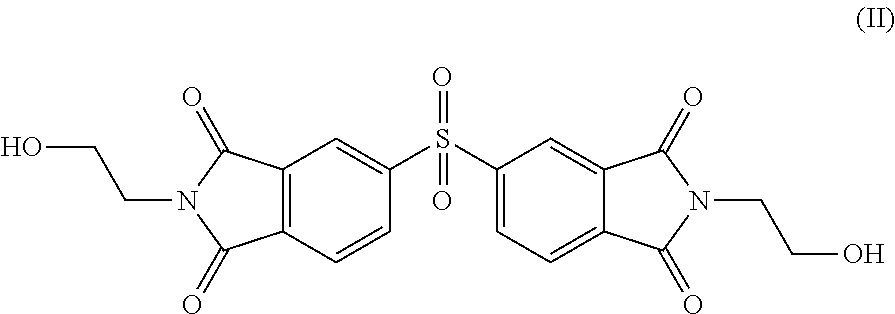Copolyesterimides derived from N,N′-bis-(hydroxyalkyl)-3,3′,4,4′-diphenylsulfonetetracarboxylic diimide and films made therefrom
a technology of copolyesters and diimides, which is applied in the field of new aromatic carboxylic acid copolyesters, can solve the problems of degradation products, high tg, and disadvantages of increasing t/sub>m, and achieve high or increased tg, improve heat resistance and thermomechanical stability, and improve the effect of tg
- Summary
- Abstract
- Description
- Claims
- Application Information
AI Technical Summary
Benefits of technology
Problems solved by technology
Method used
Image
Examples
example 1
Synthesis of (Monomer of Formula I)
[0095]Ethanolamine (0.70 g, 11.50 mmol) was added dropwise to a stirred solution of 3,3,4,4′-diphenylsulfonetetracarboxylic dianhydride (2.00 g, 5.58 mmol) in DMF (100 mL). The solution was heated to 130° C. over a period of 1 h and left to reflux for 16 h. The reflux was then stopped and the reaction mixture was cooled to 0° C. before being added to distilled water where a light yellow precipitate formed. The solution was held at 0° C. for 30 mins to induce further precipitation. The DPSDI product (1.47 g, 59%) was collected by filtration, dried in vacuo at 100° C. for 24 h and ground into a fine yellow powder. The product was characterised using standard analytical techniques as set out below.
[0096]
[0097]m.p. (DSC)=219° C. MS m / z=467.0502 [M+Na], calculated 467.0448. 1H NMR (400 MHz, d6-DMSO) δH (ppm) 8.53 (4H, m, Ha), 8.09 (2H, m, Hb), 3.64 (4H, t, J=5.81 Hz, Hc), 3.55 (4H, t, J=5.78 Hz, Hd). 13C NMR (100 MHz, d6-DMSO) δC (ppm) 166.30 (C1), 145....
examples 2 to 6
Synthesis of the Copolyesters
[0098]Two series of novel linear poly(ester-imide)s were synthesised, by polycondensation between either bis-(2-hydroxyethyl)-terephthalate (BHET) or bis-(2-hydroxyethyl)-2,6-naphthalate (BHEN) and the comonomers of formula (I), in molar amounts of comonomer from about 5 to about 25 mol %. Copolymers containing varying amounts of co-monomer were obtained using Sb2O3 as catalyst. The general polyesterification procedure is as follows, wherein the amounts of reactants used are provided in Tables 1 and 2. A stirred mixture of ester comonomer, diimide comonomer (I) and Sb2O3 (0.10 g, 0.34 mmol) was poured into a PC rig tube. The PC rig tube was lightly scored on the stem using a Stanley blade to ensure safe extrusion and clamped inside a heating block. After being fitted with a polycondensation head, stirrer guide, air stirrer, delivery side arm, distillate tube inside an ice-filled Dewar flask, thermocouples, optical revolution counter and connected to a ga...
PUM
| Property | Measurement | Unit |
|---|---|---|
| density | aaaaa | aaaaa |
| density | aaaaa | aaaaa |
| degree of crystallinity | aaaaa | aaaaa |
Abstract
Description
Claims
Application Information
 Login to View More
Login to View More - R&D
- Intellectual Property
- Life Sciences
- Materials
- Tech Scout
- Unparalleled Data Quality
- Higher Quality Content
- 60% Fewer Hallucinations
Browse by: Latest US Patents, China's latest patents, Technical Efficacy Thesaurus, Application Domain, Technology Topic, Popular Technical Reports.
© 2025 PatSnap. All rights reserved.Legal|Privacy policy|Modern Slavery Act Transparency Statement|Sitemap|About US| Contact US: help@patsnap.com



